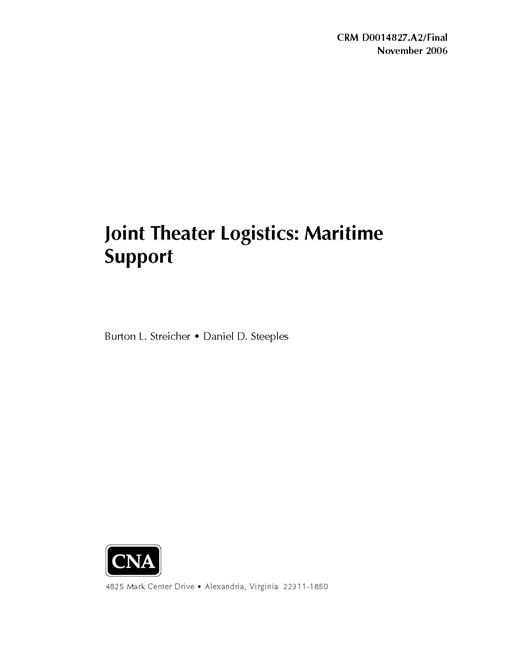The Director, Supply, Ordnance, and Logistics Operations Division (N41) requested that the Center for Naval Analyses (CNA) examine the feasibility of better integration of current Navy logistics practices and organizational structure into joint theater logistics (JTL). We explored the evolving maritime element of JTL and the Navy’s role in supporting it. We found that new joint logistics doctrine is being rapidly developed as part of the overall DOD transformation effort and that each military Service has a different approach to accomplishing focused logistics.
We discovered that Navy maritime JTL issues lie in several areas. Title 10 U.S. Code provides logistics authority to both Services and the Combatant Commanders (COCOMs) which results in a concern of possible overlap of responsibility and duplication of efforts. Under the standard joint organizational structure, maritime JTL support is included under the surface operations branch and is doctrinally treated the same as land-based logistics. Peacetime and warfighting structures are different which could result in confusion and communication breakdowns during future contingencies. In addition, there currently is little maritime common user tactical lift capability to support JTL. Finally, current maritime logistical support plans assume a benign operating environment, which may not be realistic in tomorrow’s world situation.
We determined that the COCOMs desire to see/sense real-time logistics across their entire theater of operation. They want to respond to warfighter needs by directing logistics flow through control of common user logistics lift. Finally, the COCOMs want to be able to collaborate with other nations, agencies, other COCOMs, and Service components to maximize their JTL capability. It appears, not surprisingly, that each military Service has approached JTL with a focus of fixing the most critical problems in their current
logistics practices. The Army’s Distribution Management tries to speed up distribution in the supply channels and reduce the size of their intermediate staging bases. Their key focus is the last tactical mile and their most critical problem is force protection of land based logistics channels. They are also dealing with the throughput limitations of strategic and tactical airlift as they work to become more expeditionary and agile in their troop deployment.
The Air Force’s Expeditionary Agile Combat Support program concentrates on the ability to add foreign airfields as Forward Operating Locations (FOLs) to their node-to-node logistics distribution system. They are limited by host nation agreements and the relatively small transport capacity of their airlift cargo aircraft. They also face the risk that infrastructure capital investments may be lost on a moment’s notice if the host country decides to exercise their sovereignty and evict them from the operating location. It is also difficult and time-consuming to convert a bare airfield into an Air Force FOL. Their focus is to push the strategic airlift as far into the theater as possible to reduce handling and lighten the requirements for tactical airlift.
The Marine Corps has embraced Precision Logistics which is task- organized and tailored to their expeditionary operational basis. They have focused on rapid introduction of logistics over-the-shore from pre-positioning maritime assets as well as combat logistics force ves- sels. The Marine Corps has pioneered the concept of a sea base for force projection and their experience is shaping much of the current sea base concept development. However, the Marine Corps and the Navy who supports them, have difficulty in building logistics supply channels more than 50 to 100 miles inland and maintaining support for more than 60 days. By current doctrine, the Marine Corps in a joint environment is to rely on the Army logistics support system after the initial 60 days of operation. However, they then experience the same issues and difficulties that Army units encounter.
Download reportApproved for Public Release; Distribution Unlimited.
Details
- Pages: 124
- Document Number: CRM D0014827.A2/Final
- Publication Date: 11/1/2006
